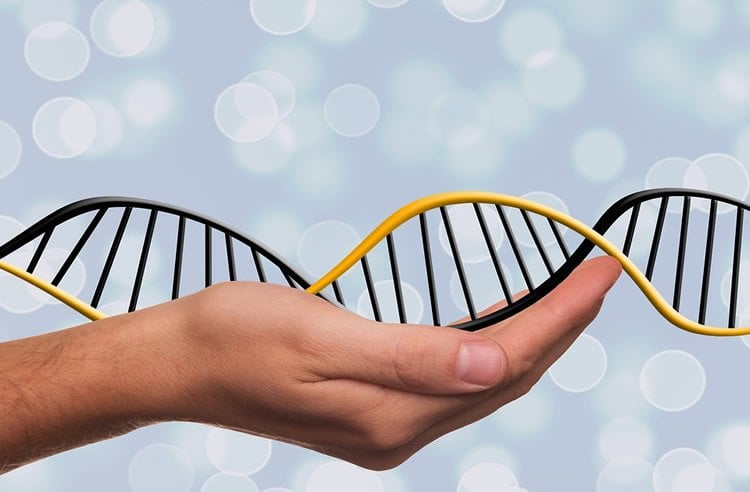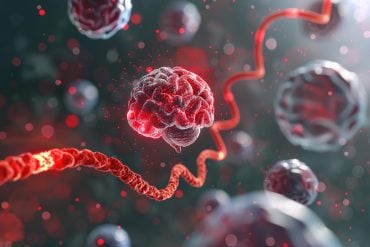Summary: Genome wide analysis of anorexia identifies the common roots the disease shares with metabolic and psychiatric traits.
Source: UNC Health Care.
UNC researchers led the most powerful genomic study of anorexia nervosa conducted to date to identify the common roots anorexia shares with psychiatric and metabolic traits
A landmark study led by UNC School of Medicine researchers has identified the first genetic locus for anorexia nervosa and has revealed that there may also be metabolic underpinnings to this potentially deadly illness.
The study, which is the most powerful genetic study of anorexia nervosa conducted to date, included genome-wide analysis of DNA from 3,495 individuals with anorexia nervosa and 10,982 unaffected individuals.
If particular genetic variations are significantly more frequent in people with a disorder compared to unaffected people, the variations are said to be “associated” with the disorder. Associated genetic variations can serve as powerful pointers to regions of the human genome where disorder-causing problems reside, according to the National Human Genome Research Institute.
“We identified one genome-wide significant locus for anorexia nervosa on chromosome 12, in a region previously shown to be associated with type 1 diabetes and autoimmune disorders,” said lead investigator, Cynthia Bulik, PhD, FAED, founding director of the UNC Center of Excellence for Eating Disorders and a professor at Karolinska Institutet in Stockholm, Sweden.
“We also calculated genetic correlations — the extent to which various traits and disorders are caused by the same genes,” said Bulik.
“Anorexia nervosa was significantly genetically correlated with neuroticism and schizophrenia, supporting the idea that anorexia is indeed a psychiatric illness.”
“But, unexpectedly, we also found strong genetic correlations with various metabolic features including body composition (BMI) and insulin-glucose metabolism. This finding encourages us to look more deeply at how metabolic factors increase the risk for anorexia nervosa,” Bulik said.
This study was conducted by the Psychiatric Genetics Consortium Eating Disorders Working Group – an international collaboration of researchers at multiple institutions worldwide.
“In the era of team science, we brought over 220 scientists and clinicians together to achieve this large sample size. Without this collaboration we would never have been able to discover that anorexia has both psychiatric and metabolic roots,” said Gerome Breen, PhD, of King’s College London.

“Working with large data sets allows us to make discoveries that would never be possible in smaller studies,” said Laramie Duncan, PhD, of Stanford University, who served as lead analyst on the project.
The researchers are continuing to increase sample sizes and see this as the beginning of genomic discovery in anorexia nervosa. Viewing anorexia nervosa as both a psychiatric and metabolic condition could ignite interest in developing or repurposing medications for its treatment where currently none exist.
Institutions that participated in this research include the University of North Carolina at Chapel Hill; Karolinska Institutet; King’s College London; Stanford University; the Broad Institute of MIT and Harvard University; Massachusetts General Hospital; Charité-Universtätmedizin Berlin; the department of child and adolescent psychiatry at the University of Duisberg, Essen; and the Wellcome Trust Sanger Institute.
Funding: Genome wide analysis of anorexia identifies the common roots the disease shares with metabolic and psychiatric traits.
Source: Caroline Curran – UNC Health Care
Image Source: NeuroscienceNews.com image is in the public domain.
Original Research: Abstract for “Significant Locus and Metabolic Genetic Correlations Revealed in Genome-Wide Association Study of Anorexia Nervosa” by Laramie Duncan, Ph.D., Zeynep Yilmaz, Ph.D., Helena Gaspar, Ph.D., Raymond Walters, Ph.D., Jackie Goldstein, Ph.D., Verneri Anttila, Ph.D., Brendan Bulik-Sullivan, Ph.D., Stephan Ripke, M.D., Ph.D., Eating Disorders Working Group of the Psychiatric Genomics Consortium, Laura Thornton, Ph.D., Anke Hinney, Ph.D., Mark Daly, Ph.D., Patrick F. Sullivan, M.D., F.R.A.N.Z.C.P., Eleftheria Zeggini, Ph.D., Gerome Breen, Ph.D., and Cynthia M. Bulik, Ph.D. in American Journal of Psychiatry. Published online April 4 2017 doi:10.1176/appi.ajp.2017.16121402
[cbtabs][cbtab title=”MLA”]UNC Health Care “Genetic Locus on Chromosome 12 Implicated in Anorexia NervosaIdentified.” NeuroscienceNews. NeuroscienceNews, 12 May 2017.
<https://neurosciencenews.com/genetics-chromosome-12-anorexia-6662/>.[/cbtab][cbtab title=”APA”]UNC Health Care (2017, May 12). Genetic Locus on Chromosome 12 Implicated in Anorexia NervosaIdentified. NeuroscienceNew. Retrieved May 12, 2017 from https://neurosciencenews.com/genetics-chromosome-12-anorexia-6662/[/cbtab][cbtab title=”Chicago”]UNC Health Care “Genetic Locus on Chromosome 12 Implicated in Anorexia NervosaIdentified.” https://neurosciencenews.com/genetics-chromosome-12-anorexia-6662/ (accessed May 12, 2017).[/cbtab][/cbtabs]
Abstract
Significant Locus and Metabolic Genetic Correlations Revealed in Genome-Wide Association Study of Anorexia Nervosa
Objective:
The authors conducted a genome-wide association study of anorexia nervosa and calculated genetic correlations with a series of psychiatric, educational, and metabolic phenotypes.
Method:
Following uniform quality control and imputation procedures using the 1000 Genomes Project (phase 3) in 12 case-control cohorts comprising 3,495 anorexia nervosa cases and 10,982 controls, the authors performed standard association analysis followed by a meta-analysis across cohorts. Linkage disequilibrium score regression was used to calculate genome-wide common variant heritability (single-nucleotide polymorphism [SNP]-based heritability [h2SNP]), partitioned heritability, and genetic correlations (rg) between anorexia nervosa and 159 other phenotypes.
Results:
Results were obtained for 10,641,224 SNPs and insertion-deletion variants with minor allele frequencies >1% and imputation quality scores >0.6. The h2SNP of anorexia nervosa was 0.20 (SE=0.02), suggesting that a substantial fraction of the twin-based heritability arises from common genetic variation. The authors identified one genome-wide significant locus on chromosome 12 (rs4622308) in a region harboring a previously reported type 1 diabetes and autoimmune disorder locus. Significant positive genetic correlations were observed between anorexia nervosa and schizophrenia, neuroticism, educational attainment, and high-density lipoprotein cholesterol, and significant negative genetic correlations were observed between anorexia nervosa and body mass index, insulin, glucose, and lipid phenotypes.
Conclusions:
Anorexia nervosa is a complex heritable phenotype for which this study has uncovered the first genome-wide significant locus. Anorexia nervosa also has large and significant genetic correlations with both psychiatric phenotypes and metabolic traits. The study results encourage a reconceptualization of this frequently lethal disorder as one with both psychiatric and metabolic etiology.
“Significant Locus and Metabolic Genetic Correlations Revealed in Genome-Wide Association Study of Anorexia Nervosa” by Laramie Duncan, Ph.D., Zeynep Yilmaz, Ph.D., Helena Gaspar, Ph.D., Raymond Walters, Ph.D., Jackie Goldstein, Ph.D., Verneri Anttila, Ph.D., Brendan Bulik-Sullivan, Ph.D., Stephan Ripke, M.D., Ph.D., Eating Disorders Working Group of the Psychiatric Genomics Consortium, Laura Thornton, Ph.D., Anke Hinney, Ph.D., Mark Daly, Ph.D., Patrick F. Sullivan, M.D., F.R.A.N.Z.C.P., Eleftheria Zeggini, Ph.D., Gerome Breen, Ph.D., and Cynthia M. Bulik, Ph.D. in American Journal of Psychiatry. Published online April 4 2017 doi:10.1176/appi.ajp.2017.16121402






